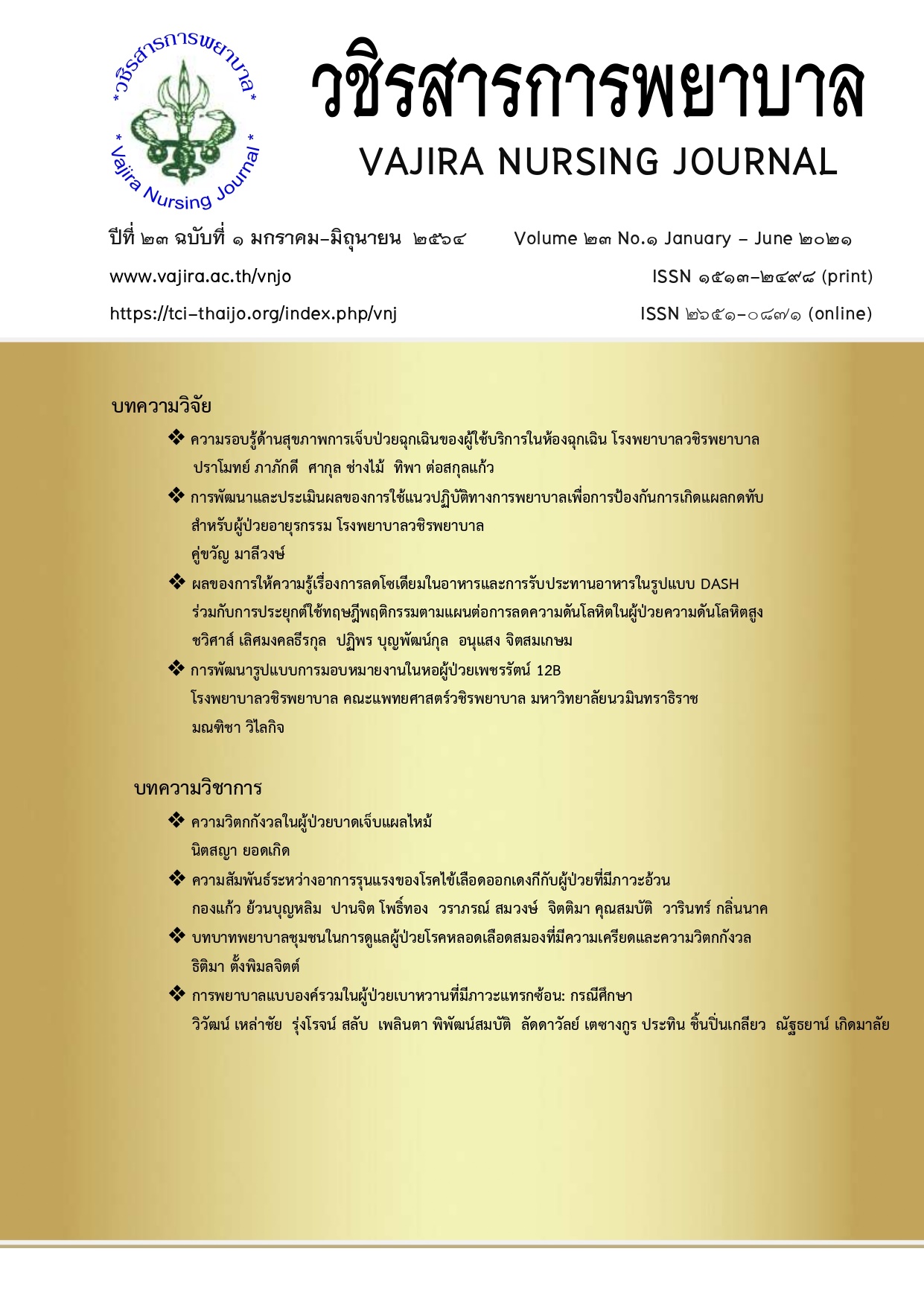ผลของการให้ความรู้เรื่องการลดโซเดียมในอาหารและการรับประทานอาหาร ในรูปแบบ DASH ร่วมกับการประยุกต์ใช้ทฤษฎีพฤติกรรมตามแผนต่อการลดความดันโลหิตในผู้ป่วยความดันโลหิตสูง
Main Article Content
บทคัดย่อ
การวิจัยในครั้งนี้ดำเนินการวิจัยแบบกึ่งทดลอง (Quasi - experimental research) โดยทำการวัดผลก่อนและหลังการทดลอง มีวัตถุประสงค์เพื่อศึกษาเปรียบเทียบ ระดับความดันโลหิต เจตคติ การคล้อยตามกลุ่มอ้างอิง การรับรู้ความสามารถของตนเอง และพฤติกรรมต่อการรับประทานอาหารตามแนวทาง DASH ตามทฤษฎีพฤติกรรมตามแบบแผน เพื่อควบคุมความดันโลหิต ระหว่างก่อนและหลังการเข้าร่วมโปรแกรมการให้ความรู้เรื่องการลดโซเดียมในอาหารและการรับประทานอาหารในรูปแบบ DASH ร่วมกับการประยุกต์ใช้ทฤษฎีพฤติกรรมตามแบบแผน
ดำเนินการวิจัย ในผู้ป่วยความดันโลหิตสูง อายุตั้งแต่ 20 ปีขึ้นไป ที่เข้ารับการรักษาที่ห้องตรวจหัวใจและหลอดเลือด คณะแพทยศาสตร์วชิรพยาบาล จำนวน 75 คน เข้าร่วมโปรแกรมการให้ความรู้ผ่านสื่อแอปพลิเคชั่น Line ในการสื่อสารและให้ข้อมูลอย่างต่อเนื่อง โปรแกรมการให้ความรู้เรื่องการลดโซเดียมในอาหารและการรับประทานอาหารในรูปแบบ DASH ร่วมกับการประยุกต์ใช้ทฤษฎีพฤติกรรมตามแบบแผนต่อการลดความดันโลหิตในผู้ป่วยความดันโลหิตสูง Ajzen (1991) มาเป็นกรอบในการสร้างโปรแกรมซึ่งประกอบด้วยกิจกรรมดังนี้ 1) สร้างเจตคติต่อการรับประทานอาหารในรูปแบบ DASH 2) สร้างการคล้อยตามกลุ่มอ้างอิง 3) สร้างการรับรู้ความสามารถของตนเอง 4) สร้างพฤติกรรมการรับประทานอาหาร 5) ประเมินผลการใช้โปรแกรมในแต่ละกิจกรรม โดยใช้เอกสารและสื่อวีดิทัศน์ในการให้ความรู้ ได้แก่ คู่มือแนะนำการควบคุมความดันโลหิตตามแนวทาง DASH วีดิทัศน์คำแนะนำการรับประทานอาหารในรูปแบบ DASH ผู้วิจัยเก็บข้อมูลตามแบบสอบถามที่ได้พัฒนามาจากการทบทวนวรรณกรรมตามกรอบแนวคิดทฤษฎีตามแบบแผนของ Ajzen ระยะเวลาในการติดตามประเมินทุกวันเป็นเวลา 3 สัปดาห์
ผลการวิจัย พบว่า ภายหลังการเข้าร่วมโปรแกรม กลุ่มตัวอย่างมีค่าเฉลี่ยความดันโลหิตช่วงบน และช่วงล่างต่ำกว่าก่อนเข้าร่วมโปรแกรม อย่างมีนัยสำคัญทางสถิติ (p - value < 0.001) เนื่องมาจากในโปรแกรมมีรูปแบบการบรรยายโดยใช้คลิป VDO บรรยายผ่านสื่อโซเชียล (Line group) มีการแลกเปลี่ยนเรียนรู้ประสบการณ์ และมีการติดตามผลอย่างต่อเนื่อง จนเกิดพฤติกรรมการรับประทานอาหารที่ดีขึ้น
ข้อเสนอแนะ การศึกษาในครั้งนี้รวมรวมข้อมูลเพียง 3 สัปดาห์ ซึ่งระยะเวลาอาจส่งผลต่อการปรับพฤติกรรมในระยะยาว ดังนั้นควรมีการวิจัยเชิงทดลองต่อเนื่อง และติดตามผลในระยะกลาง และระยะยาว รวมทั้งประยุกต์ใช้นวัตกรรมและช่องทางการสื่อสารที่สอดคล้องกับวิถีชีวิต จะช่วยให้พฤติกรรมในการดูแลสุขภาพด้วยโปรแกรมการปรับอาหารด้วยวิธี DASH เกิดความยั่งยืน และส่งเสริมให้ผู้ป่วยมีคุณภาพชีวิตที่ดี
Article Details

อนุญาตภายใต้เงื่อนไข Creative Commons Attribution-NonCommercial-NoDerivatives 4.0 International License.
เนื้อหาและข้อมูลในบทความที่ลงตีพิมพ์ในวชิรสารการพยาบาลถือเป็นข้อคิดเห็นและความรับผิดชอบของผู้เขียนบทความโดยตรง ซึ่งกองบรรณาธิการไม่จำเป็นต้องเห็นด้วย หรือร่วมรับผิดชอบใด ๆ ทั้งสิ้น
บทความ ข้อมูล เนื้อหา รูปภาพ ฯลฯ ที่ได้รับการตีพิมพ์ในวชิรสารการพยาบาล ถือเป็นลิขสิทธิ์ของวชิรสารการพยาบาล หากบุคคลใดหรือหน่วยงานใดต้องการนำทั้งหมดหรือส่วนหนึ่งส่วนใดไปเผยแพร่ต่อหรือเพื่อกระทำการใด ๆ จะต้องได้รับอนุญาตเป็นลายลักอักษรจากวชิรสารการพยาบาลก่อนเท่านั้น
เอกสารอ้างอิง
กนกวรรณ อุดมพิทยารัชต์. (2557). โปรแกรมสุขศึกษาโดยประยุกต์ทฤษฏีการรับรู้ความสามารถตนเองเพื่อส่งเสริมพฤติกรรม การออกกำลังกายของผู้ป่วยโรคความดันโลหิตสูงชนิดไม่ทราบสาเหตุ. Veridian E-Journal Silpakorn University (Humanities, Social Sciences, and Arts), 7(1), 11.
กองการแพทย์ทางเลือก กรมการแพทย์แผนไทยและการแพทย์ทางเลือก. (2563). แดชไดเอท (DASH Diet) บำบัดโรคความดันโลหิตสูง. (วี อินดี้ ดีไซน์ จำกัด ed.): กรุงเทพฯ.
พัชราวดี ทองเนื่อง, อัญณ์ยภัคสร ใจสมคม. (2562). ปัจจัยทำนายความตั้งใจในการปฏิบัติตนเพื่อป้องกันการเกิด โรคความดันโลหิตสูงของประชากรวัยผู้ใหญ่. วารสารพยาบาลโรคหัวใจและทรวงอก, 30(2), 49-65.
พิชิต ฤทธิ์จรูญ. (2544). หลักการวัดผลและประเมินผลการศึกษา (คณะครุศาสตร์ สถาบันราชภัฏพระนคร ed.): กรุงเทพมหานคร.
ยุภาพร นาคกลิ้ง. (2560). ผลของการประยุกต์ทฤษฎีความสามารถตนต่อ พฤติกรรมการควบคุมอาหาร การออกกำลังกาย และระดับความดันโลหิตของผู้สูงอายุโรคความดันโลหิตสูง. Journal of Health and Nursing Research (Journal of Boromarajonani College of Nursing, Bangkok), 28(1), 1-12.
สถาบันวิจัยประชากรและสังคม มหาวิทยาลัยมหิดล. (2563). สุขภาพคนไทย 2563 (พิมพ์ครั้งที่ 1.): บริษัทอมรินทร์พริ้นติ้ง แอนด์พับลิชชิ่ง จำกัด (มหาชน)
สำนักโรคไม่ติดต่อ กรมควบคุมโรค. (2561). ประเด็นสารรณรงค์วันความดันโลหิตสูงโลก. Retrieved from http://thaincd.com/document/file/
สุดฤทัย รัตนโอภาส. (2560). ประสิทธิผลของโปรแกรมการดูแลสุขภาพตนเองของผู้ป่วยความดันโลหิตสูง โรงพยาบาลปากน้ำชุมพร. วารสารอายุรศาสตร์ มหาวิทยาลัยขอนแก่น, 3(4), 59-66.
เสาวลักษณ์ มูลสาร, เกษร สำเภาทอง. (2559). ผลของโปรแกรมปรับเปลี่ยนพฤติกรรมการบริโภคอาหารตามแนวทางของ DASH ร่วมด้วยทฤษฎีการรับรู้ความสามารถแห่งตน และแรงสนับสนุนทางสังคมเพื่อลดความเสี่ยงต่อโรคความดันโลหิตสูง. วารสารสาธารณสุขมหาวิทยาลัยบูรพา, 11(1), 87-98.
Ajzen, I. 1 99 1."The Theory of Planned Behavior". Organizational behavior and human decision processes, 50(2), 179-121.
Chen, Y. (2012). S., dan Chang, CH (2012). Enhance Green Purchase Intentions: The Roles Of Green Perceived Value, Green Perceived Risk, And Green Trust. Management Decision, 50 (3): 502, 520.
Dehghanan, H. & Bakhshandeh, G. (2014). The impact of green perceived value and green perceived risk on green purchase behavior of Iranian consumers. International Journal of Management and Humanity Sciences, 3(2), 1349-1357.
Huang, Y.-C., Yang, M., & Wang, Y.-C. (2014). Effects of green brand on green purchase intention. Marketing Intelligence & Planning.
World Health Organization. (2013). A global brief on hypertension: silent killer, global public health crisis: World Health Day 2013. Retrieved from
World Health Organization. (2015). Q & As on hypertension. Retrieved from http://www.who.int/features/qa/82/en/
YAMANE, T. (1973). Statistics. An introductory analysis. Third edition: Harper & Row.


